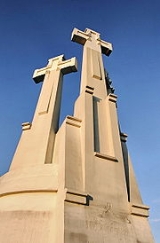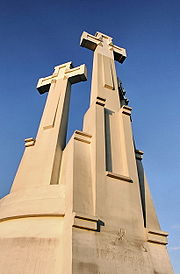
Three Crosses
Encyclopedia

Vilnius
Vilnius is the capital of Lithuania, and its largest city, with a population of 560,190 as of 2010. It is the seat of the Vilnius city municipality and of the Vilnius district municipality. It is also the capital of Vilnius County...
, Lithuania
Lithuania
Lithuania , officially the Republic of Lithuania is a country in Northern Europe, the biggest of the three Baltic states. It is situated along the southeastern shore of the Baltic Sea, whereby to the west lie Sweden and Denmark...
, designed by Polish–Lithuanian
Polish-Lithuanian (adjective)
Polish-Lithuanian individuals and groups are those with histories in the Polish-Lithuanian Commonwealth. This federation, formally established by the 1569 Union of Lublin between the Kingdom of Poland and Grand Duchy of Lithuania, created a multi-ethnic and multi-confessional state founded on the...
architect and sculptor Antoni Wiwulski
Antoni Wiwulski
Antoni Wiwulski was a Polish- Lithuanian architect and sculptor.He was born February 20, 1877 in Totma near Vologda in Imperial Russia, where his father, of Lithuanian origin, served as a forest superintendent...
in 1916. It was torn down in 1950 by order of the Soviet Union
Soviet Union
The Soviet Union , officially the Union of Soviet Socialist Republics , was a constitutionally socialist state that existed in Eurasia between 1922 and 1991....
authorities. A new monument designed by Henrikas Šilgalis was erected in its place in 1989.
History
It was constructed in Kalnai ParkKalnai Park
Kalnai Park is a park between the left bank of the Neris River and right bank of the Vilnia River in Vilnius, Lithuania. It lies within the Vilnius Old Town elderate near Gediminas Hill and Gediminas Tower, and is part of the State Cultural Reserve of Vilnius Castles, established in 1997. The...
on the Hill of Three Crosses (alternatively, the Bleak Hill ) in 1916, in the place where the three wooden crosses used to stand at least since 1636. The wooden crosses collapsed in 1869 and tsarist authorities did not allow for them to be rebuilt. The new monument by Antoni Wiwulski
Antoni Wiwulski
Antoni Wiwulski was a Polish- Lithuanian architect and sculptor.He was born February 20, 1877 in Totma near Vologda in Imperial Russia, where his father, of Lithuanian origin, served as a forest superintendent...
was covertly erected in 1916. It was blown up under the order of the Soviet Government on 30 May 1950. Eventually the crosses were restored and consecrated on 14 June 1989.
The Three Crosses are constructed of concrete
Concrete
Concrete is a composite construction material, composed of cement and other cementitious materials such as fly ash and slag cement, aggregate , water and chemical admixtures.The word concrete comes from the Latin word...
, painted in white. The rebuilt crosses now are 1.8 metre higher than those of 1916. The fractured remains of original crosses are on display on an elevation several meters below. A spectacular panorama
Panorama
A panorama is any wide-angle view or representation of a physical space, whether in painting, drawing, photography, film/video, or a three-dimensional model....
of the Vilnius Old Town
Vilnius Old Town
The Old Town of Vilnius , one of the largest surviving medieval old towns in Northern Europe, has an area of 3.59 square kilometres . It encompasses 74 quarters, with 70 streets and lanes numbering 1487 buildings with a total floor area of 1,497,000 square meters...
can be observed from top of the hill.
Legend

Bychowiec Chronicle
The Bychowiec Chronicle named the Letopis of the Grand Dukes of Lithuania is an anonymous 16th century chronicle of the Grand Duchy of Lithuania. Although one of the least reliable sources of the epoch, it is considered the most complete redaction of the Lithuanian Chronicles...
among others, according to which seven Franciscan
Franciscan
Most Franciscans are members of Roman Catholic religious orders founded by Saint Francis of Assisi. Besides Roman Catholic communities, there are also Old Catholic, Anglican, Lutheran, ecumenical and Non-denominational Franciscan communities....
monks, who were invited to Vilnius
Vilnius
Vilnius is the capital of Lithuania, and its largest city, with a population of 560,190 as of 2010. It is the seat of the Vilnius city municipality and of the Vilnius district municipality. It is also the capital of Vilnius County...
from Podolia
Podolia
The region of Podolia is an historical region in the west-central and south-west portions of present-day Ukraine, corresponding to Khmelnytskyi Oblast and Vinnytsia Oblast. Northern Transnistria, in Moldova, is also a part of Podolia...
by Petras Goštautas, were torture
Torture
Torture is the act of inflicting severe pain as a means of punishment, revenge, forcing information or a confession, or simply as an act of cruelty. Throughout history, torture has often been used as a method of political re-education, interrogation, punishment, and coercion...
d to death (crucified
Crucifixion
Crucifixion is an ancient method of painful execution in which the condemned person is tied or nailed to a large wooden cross and left to hang until dead...
and thrown into the Vilnia River
Vilnia River
Vilnia is a river in Lithuania. Its source is near the village of Vindžiūnai, 5 km south of Šumskas, at the Lithuanian-Belarusian border. The Vilnia is 79.6 km long and its basin covers 624 sq. km...
, according to some sources) on 4 March 1333 by local pagan
Paganism
Paganism is a blanket term, typically used to refer to non-Abrahamic, indigenous polytheistic religious traditions....
inhabitants. The chapel was erected on the spot where they died and the crosses were added later on.
The factual background of the legend is a story regarding two murdered Franciscan friar
Friar
A friar is a member of one of the mendicant orders.-Friars and monks:...
s who came to Vilnius
Vilnius
Vilnius is the capital of Lithuania, and its largest city, with a population of 560,190 as of 2010. It is the seat of the Vilnius city municipality and of the Vilnius district municipality. It is also the capital of Vilnius County...
to spread Christianity, that was first presented in Chronica XXIV Generalium
Chronica XXIV Generalium
The Chronica XXIV Generalium Ordinis Fratrum Minorum is a medieval chronicle written in Latin around 1370, possibly by the Franciscan monk Arnaud de Sarrant, though Lützelschwab doubts this attribution...
, written before 1369. The events probably took place around 1340; therefore some eyewitnesses could still have been alive. According to the story, Franciscan friar's Ulrich's preaching angered townspeople. He and his companion Martin were seized and brought before Grand Duke of Lithuania Gediminas, who ordered the friars killed. Ulrich was tortured and his body tossed into the river. Martin's body was rescued by Gediminas' sister, an Orthodox nun. She buried Martin in a monastery she lived in.
The true purpose of building Three Crosses on the hill is still unknown. One of the suggestions is that they were erected in the celebration of granting Magdeburg rights
Magdeburg rights
Magdeburg Rights or Magdeburg Law were a set of German town laws regulating the degree of internal autonomy within cities and villages granted by a local ruler. Modelled and named after the laws of the German city of Magdeburg and developed during many centuries of the Holy Roman Empire, it was...
to the city.

